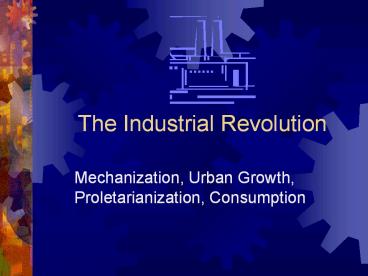The Industrial Revolution - PowerPoint PPT Presentation
Title:
The Industrial Revolution
Description:
The Industrial Revolution Mechanization, Urban Growth, Proletarianization, Consumption Mechanization During the first half of the 19th century, the European ... – PowerPoint PPT presentation
Number of Views:47
Avg rating:3.0/5.0
Title: The Industrial Revolution
1
The Industrial Revolution
- Mechanization, Urban Growth, Proletarianization,
Consumption
2
Mechanization
- During the first half of the 19th century, the
European manufacturing process shifted from
small-scale production by hand at home to
large-scale production by machine in a factory
setting.
3
At the Expense of Workers
- The shift meant high quality products at
competitive prices, but often at the expense of
workers. For example, the raw wool and cotton
that fed the British textile mills came from - Lands converted from farming to sheep raising,
leaving farm workers without jobs - The southern plantations of the United States,
which were dependent upon slave labor
4
Urban Growth
- Those who could no longer make a living on the
land migrated from the countryside to the cities
to seek work in the factories.
5
Population Growth
- At the same time, the population of Europe
continued to grow.
6
The Plight of the Cities
- The sheer number of human beings put pressure on
city resources - Housing, water, sewers, food supplies, and
lighting were completely inadequate.
- Slums grew and disease, especially cholera,
ravaged the population. - Crime increased and became a way of life for
those who could make a living in no other way.
7
Conditions in the Countryside
- The only successful farmers were those with large
landholdings who could afford agricultural
innovations. - Most peasants
- Didnt have enough land to support themselves
- Were devastated by poor harvests (e.g., the Irish
Potato Famine of 1845-47) - Were forced to move to the cities to find work in
the factories.
8
The Role of the Railroads
- The railroads, built during the 1830s and 1840s
- Enabled people to leave the place of their birth
and migrate easily to the cities. - Allowed cheaper and more rapid transport of raw
materials and finished products. - Created an increased demand for iron and steel
and a skilled labor force.
9
The Labor Force
- No single description could include all of these
19th century workers - Factory workers
- Urban artisans
- Domestic system craftsmen
- Household servants
- Miners
- Countryside peddlers
- Farm workers
- Railroad workers
- Variations in duties, income, and working
conditions made it difficult for them to unite.
10
The Condition of Labor
- All working people, however, faced possible
unemployment, with little or no provision for
security. - In addition, they were subject to various kinds
of discipline - The closing of factory gates to late workers
- Fines for tardiness
- Dismissal for drunkenness
- Public censure for poor quality workmanship
- Beatings for non-submissiveness
11
Prolitarianization
- During the century, factory workers underwent a
process of proletarianization (i.e., they lost
control of the means of production).
- Factory owners provided the financial capital to
construct the factory, to purchase the machinery,
and to secure the raw materials. - The factory workers merely exchanged their labor
for wages.
12
Family Structures Changed
- With the decline of the domestic system and the
rise of the factory system, family life changed. - At first, the entire family, including the
children, worked in the factory, just as they had
at home. - Later, family life became fragmented (the father
worked in the factory, the mother handled
domestic chores, the children went to school).
13
Family as a Unit of Consumption
- In short, the European family changed from being
a unit of production and consumption to being a
unit of consumption alone.
14
Gender-Determined Roles
- That transformation prepared the way for
gender-determined roles. - Women came to be associated with domestic duties,
such as housekeeping, food preparation, child
rearing and nurturing, and household management. - The man came to be associated almost exclusively
with breadwinning.































